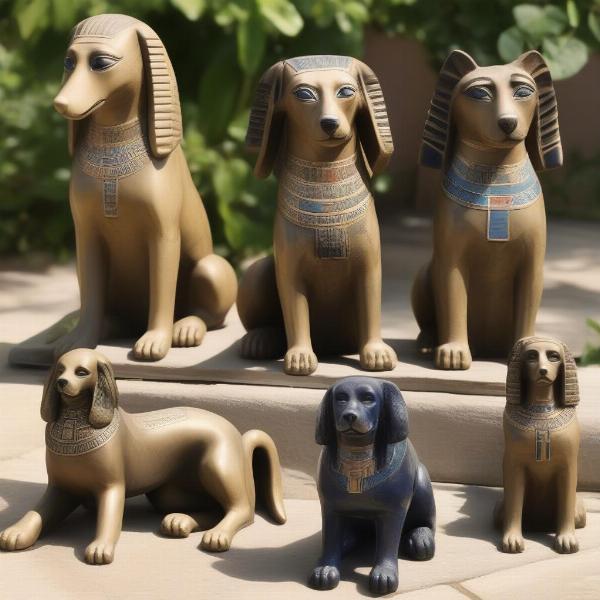Egyptian dog statues are more than just decorative objects; they’re a window into the ancient Egyptians’ deep reverence for their canine companions. These sculptures, often meticulously crafted from materials like faience, bronze, and wood, reveal a rich history of dog breeds, their roles in society, and the spiritual beliefs that intertwined humans and animals in ancient Egypt. From the noble hunting hounds to the cherished companions buried alongside their owners, Egyptian dog statues capture the enduring bond between humans and dogs.
The Significance of Dogs in Ancient Egypt
Ancient Egyptians held dogs in high esteem, recognizing their value as hunters, guardians, and companions. Dogs were not merely pets; they were integral members of society, often given names that reflected their personality or role. This deep connection is reflected in the numerous dog statues found in tombs, temples, and homes. The statues served not only as artistic expressions but also as powerful symbols of protection, loyalty, and the afterlife. Dogs like the Anubis-like deity, Wepwawet, further solidified their spiritual significance.
Popular Dog Breeds Immortalized in Stone
The breeds depicted in Egyptian dog statues offer a glimpse into the canine world of ancient Egypt. The Tesem, a sleek greyhound-like breed, was a prized hunting dog often depicted alongside pharaohs. Another common subject was the Basenji, a distinctive breed known for its curled tail and alert expression. These statues offer invaluable insights into the physical characteristics and prevalence of these ancient breeds, some of which continue to exist today.
Egyptian Dog Statues: From Guardians to Guides in the Afterlife
Egyptian beliefs about the afterlife often involved dogs. Anubis, the jackal-headed god of the dead, played a central role in guiding souls to the underworld. Dogs were also believed to offer protection and companionship in the afterlife. Some dog statues were placed in tombs to safeguard the deceased, while others were intended to serve as loyal companions in the next world.
What did the placement of dog statues in tombs signify?
The placement of dog statues within tombs often symbolized the deceased’s relationship with their canine companions. Statues placed near the sarcophagus suggest a deeply personal bond, indicating the dog’s importance in the individual’s life and their desired presence in the afterlife.
Collecting and Caring for Egyptian Dog Statues
 Antique Egyptian Dog Statue Collection
Antique Egyptian Dog Statue Collection
vintage dog statues and antique dog statue are highly sought after by collectors. When acquiring an Egyptian dog statue, it’s essential to ensure its authenticity and provenance. Replicas are also available, offering a more affordable way to appreciate the artistry and symbolism of these ancient artifacts. Whether antique or replica, proper care is crucial to preserve these treasures.
The Enduring Legacy of Egyptian Dog Statues
From their artistic beauty to their historical and spiritual significance, Egyptian dog statues continue to fascinate. They offer a tangible connection to the past, reminding us of the enduring bond between humans and dogs. These sculptures are a testament to the important role dogs played in ancient Egyptian society and the deep affection they inspired.
FAQ
- What materials were used to create Egyptian dog statues? Common materials included faience, bronze, wood, and stone.
- What is the significance of Anubis in relation to dogs? Anubis, the jackal-headed god of the dead, reinforced the spiritual connection between dogs and the afterlife.
- Where can I find authentic Egyptian dog statues? Reputable auction houses, antique dealers, and museums are potential sources. egyptian dog statue
- Are there modern replicas of Egyptian dog statues available? Yes, replicas are available, offering a more accessible way to appreciate this art form. cat and dog artwork
- How can I care for an Egyptian dog statue? Careful handling, appropriate cleaning methods, and controlled storage environments are essential for preservation. famous artwork of dogs
- What are some of the most common dog breeds depicted in these statues? The Tesem and Basenji are frequently represented.
- Why were dogs so important to ancient Egyptians? Dogs were valued as hunters, guardians, and companions, holding a significant place in society and spirituality.
Related Articles:
About ILM Dog:
ILM Dog is your trusted global resource for expert dog care advice. We offer practical guidance on everything from breed selection and puppy care to senior dog health and training. Our expertise in dog breeds, health, nutrition, and behavior ensures you have the knowledge to provide the best possible care for your canine companion. We also cover product and accessory recommendations. Contact us for personalized advice: [email protected] | +44 20-3965-8624.